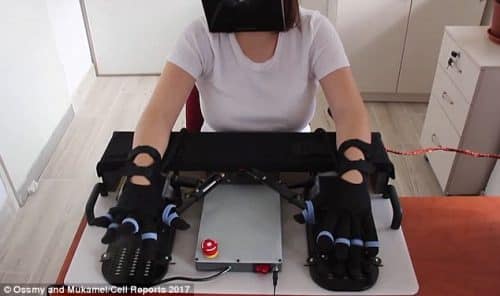The study was conducted among healthy subjects. The researchers hope that the new method will help stroke victims

Researchers at Tel Aviv University found that a person can train his hand and improve its performance even without voluntarily activating it - all this through practice methods that 'stack' the brain with the help of virtual reality technology. The research was carried out by Prof. Roy Mochmal and research student Uri Osami from the School of Psychological Sciences and the Purple School of Neuroscience at Tel Aviv University. The article was published this week (13.12.16) in the scientific journal Cell reports.
Visual manipulation
"The rehabilitation process of brain injuries in general, and stroke victims in particular, is currently based on active training of the injured limb," explains Prof. Mochmal. "The difficulty is manifested in the fact that the same limb, for example the hand, is very weak due to the neurological damage, so the training is grueling, exhausting and slow. In our study, conducted at this stage with groups of healthy subjects, we sought to examine alternative ways to improve the performance of the hand, without voluntarily activating it."
In the first stage, 18 subjects were asked to wear virtual reality glasses. Virtual hands were shown in their glasses, which seemed to them to be a natural extension of their body, but their movement was controlled by the researchers with the help of special software. In addition, the subjects wore gloves with motion sensors, which allowed the researchers to track the movements of the subject's real fingers. In this situation, the subjects were given a task: to train the right hand to perform a given sequence of touching the fingers with the thumb.
During the training, the researchers reversed the image shown to the subjects with glasses: while practicing the right hand, the participants actually saw the (virtual) left hand performing the movement in real time. An examination at the end of the training revealed that the performance of the left (real) hand, which in fact did not move at all throughout the training, improved significantly according to the index established in the study: an increase of about 15% in the number of accurate performances of the task in 30 seconds.
Right hand moves - left hand improved by 30%
In the second phase of the study, the researchers added another device: 18 new subjects were asked to place both hands inside a device that prevents them from voluntarily moving their left hand, but moves it automatically according to the movements of the right hand. In other words: the subject voluntarily trains the right hand, and the left hand imitates its actions precisely, but completely passively.
"The combination of the two techniques - virtual reality viewing and passive movement of the left hand, yielded the best results," says Prof. Mochmal. "The performance of the left hand following the combined training improved by almost an additional 30%, even though in practice the subject physically trained only his right hand."
Neural activity in the parietal lobe
In the third phase of the study, the researchers examined the brain activity of 18 additional subjects while performing the task, using fMRI (functional Magnetic Resonance Imaging) technology. They found distinct neural activity in a certain area of the brain called the parietal lobe, which is involved in processing sensory information and spatial perception. Moreover: the degree of activity observed in the parietal lobes on both sides of the brain during the training predicted the degree of improvement in the performance of the task by the left hand - all this in the absence of active and voluntary physical training of this hand.
"Our results may form the basis for the development of innovative treatment methods for patients with unilateral nerve damage (hemiparesis), for example following a stroke," Prof. Mochmel concludes. "It is possible that technologies based on the new approach will allow these patients to improve the functions of the injured hand in the future by more comfortable and easier training of the healthy hand. This is a bypass training course, which uses virtual reality to 'trick' the brain."
The study was performed among healthy subjects. These days, the researchers are engaged in follow-up research, focusing on subjects with brain damage, who are undergoing rehabilitation procedures. The goal is to examine whether the method, which worked well in healthy subjects, could also help patients with neurological damage - and improve the function of the damaged limb by training the healthy limb.
